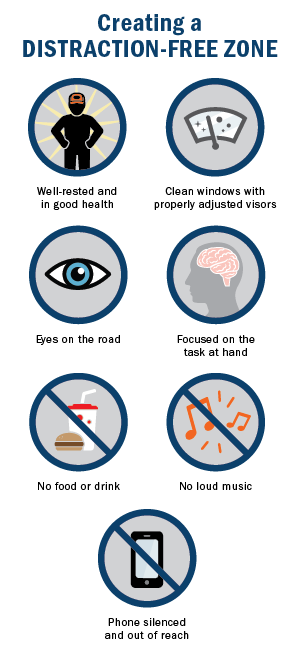
This article is from the April 2015 issue of the IC Safety newsletter. To view the full issue, visit the IC Safety archive.
Distracted driving is one of the major causes of motor vehicle collisions today. According to Distraction.gov over 3,000 motorists are killed and another 421,000 are injured each year as a result of distracted driving collisions. It's estimated that distracted driving increases chances of having a collision by up to three times.
It's important for you and your drivers to understand the different types of distracted driving exposures as well as the proper skills to avoid these distractions.
Manual distractions
These distractions occur when the hands and eyes are moved away from controlling the vehicle like texting or eating and drinking. If a driver looks down for five seconds to read a text message while traveling at 35 mph, he or she will have gone over 250 feet without their eyes on the road! The best practice is for drivers to silence their phones and never have them within reach while driving. The only safe time to look at a device is when you are safely parked and off the roadway. The DOT has prohibitions on using hand-held devices while driving a CMV.
Auditory and visual distractions
These occur when what you see or hear causes you to lose focus on the road, such as loud music, passengers, or reading billboards, signs and directions. Glare from the sun can also affect a driver's vision of the road and vehicles around them. Plan your trip in advance so it is not necessary to refer to maps, GPS or other in-cab distractions. Enjoy your view but stay focused on the view of the road and the vehicles around you.
Cognitive distractions
These distractions are the most difficult to recognize and control. They occur when a driver's mind is not focused, such as when they are fatigued, thinking about personal or work issues, battling health issues or talking on the phone.
It has been scientifically proven that our brains cannot multitask. The brain can only focus on one task at a time and must constantly switch back and forth. When talking on a cell phone, your brain is so focused on the conversation that you may "see" a hazard but your brain does not recognize it as a hazard, giving you no time to react safely. Hands-free devices do NOT eliminate the cognitive distraction.
What can you do?
- Develop a formal written policy that strictly prohibits all forms of distracted driving at your company. Ask drivers to Take the Pledge with the U.S. Department of Transportation.
- Discuss and issue this policy to your drivers and have them acknowledge receipt by signing off.
- Train your drivers regularly on the dangers of distracted driving, among other safety topics.
- Observe your drivers, hold them accountable through progressive discipline and provide coaching for improvement.
Distracted driving is a serious issue that cannot be taken lightly. Take steps to turn your vehicle into a distraction-free zone.
Categorized in:
-
Driving Techniques
-
Distracted Driving
-
Transportation Safety
ClickToAddCategories
No categories have been created yet.
Community
Company Updates
Driver Recruitment
Investor News
Transportation Safety
Claims
Driver Management
Driving Techniques
Distracted Driving
Seasonal Driving Tips
Sharing the Road
Health & Wellness
Injury Prevention
Regulations
Security & Cargo Theft
Vehicle Inspections
Weather Conditions
Workplace Safety
Workers Compensation
Done